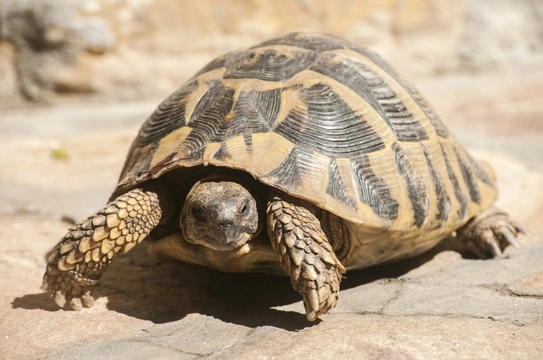
The basics of caring for a tortoise
Thirty or forty years ago, tortoises were a very common pet in the UK, and most streets had a couple of families that would have a tortoise wandering around the garden in the summer, and boxed up carefully to hibernate during the cooler months of the year. However, tortoise ownership is a lot less common these days, which is due to many different factors including an appreciation of the real care needs of tortoises, the fact that they are classed as exotic pets, and import restrictions on breeds that are at risk or becoming scarce in their native habitats.
There is a lot to recommend tortoise ownership for many people, who find these unusual and often long-lived animals fascinating and rewarding, but there is much more to keeping a pet tortoise than simply going to a pet shop, buying one, and feeding it lettuce!
In this article, we will look at what is involved in the very basic principles of caring for a tortoise in more detail, as a form of primer that is not intended to provide you with enough information to be ready to go out and buy one, but to help to provide a little perspective on what is involved. Read on to learn more.
Tortoise ownership and the law
Many different species of tortoises are protected by legislation in the UK, which monitors the import and ownership of certain breeds that are rare or vulnerable in the wild.
This means that depending on what species of tortoise you decide to get, you will need to hold a permit to own one, and these permits serve as a type of pet passport that goes with the tortoise any time it comes under new ownership. This falls under the umbrella of CITES (Convention on International Trade in Endangered Species) and also, EU law.
Once you have researched the different species of tortoise and decided what type would best suit you, it is important that you then check their status on the CITES database, and ensure that you receive the relevant paperwork with your new pet when you buy it; failing which, you will be in contravention of the law.
Different species of tortoise
As we alluded to above, tortoises come in a great many types and species, some of which don’t grow particularly large, but others of which can reach truly massive sizes, and may well outlive not only yourself but also your children and potentially grandchildren as well!
Different types of tortoises have greatly varying care requirements in terms of what they eat, how long they live and how to take care of them properly, and once you have decided what species you would like to own, it is really important to research all of these things in detail.
Additionally, it is very important to learn how to identify the different species of tortoise at different ages from young to adult, in order to avoid inadvertently buying something other than you expected from an unscrupulous seller who may tell you that their small tortoise is a fully grown adult from one breed, when it is in fact a youngster from a different species that may grow very large!
What do tortoises eat?
The precise dietary requirements of tortoises vary considerably from species to species, and of course, larger species need a large volume of food every day as well! Again, this makes researching your potential new pet by species to ensure that you can provide for their needs, and offer them a complete and healthy diet that provides the appropriate nutrition, very important.
Many people assume that tortoises are vegetarian, when in fact they are omnivores, which can eat both meat and vegetables. Species like Red-footed tortoises require a balanced diet that includes a weekly portion of protein, as a strictly vegetarian diet does not meet their nutritional needs.
There are various types of commercial tortoise diets available to take some of the hassle out of feeding your pet, but these are not, despite the way that they are branded, generally truly complete diets; tortoises graze a lot, eating grass, weeds like dandelions and the occasional berry, but contrary to popular belief, fruit is not something that they generally eat in the wild, and should not be given to pet tortoises either.
When it comes to water, the best way to provide your tortoise with a drink is to use a shallow-sided dish that they can easily climb into without getting swamped, allowing them to drink as needed. It’s worth mentioning that most pet store water dish options can be a known flipping hazard due to their smooth surfaces, making it difficult for tortoises to right themselves if they tip over. The safest option is a clay terracotta saucer, which is both sturdy and large enough for the tortoise to soak in comfortably.
Housing tortoises
While many tortoise owners like to see their pets grazing around the garden in nice weather, it is vitally important to provide a safe enclosure for your pet so that they can rest, keep warm and vitally, stay safe from predators.
All baby tortoises should be housed in a closed set up to maintain high humidity. It could however be stated that closed set ups do better retaining heat. For species like red foots with life long high humidity requirements, a closed set up is mandatory.
Tortoises can be kept as indoor-only pets, but ideally, should spend as much time outside as possible. The recommended minimum size for smaller species like Russians and Hermans is as close to 8x4 feet as possible.
Brumation
Brumation is the term used to describe the "hibernation" of tortoises. It's a common misconception that all tortoise species hibernate during the winter, but this is not true. Some species require brumation, some can brumate, and others do not brumate at all. It's crucial to research each species individually for accurate information.
For more information on the species of tortoise that are commonly hibernated and a short guide on how to do it, check out this article.



